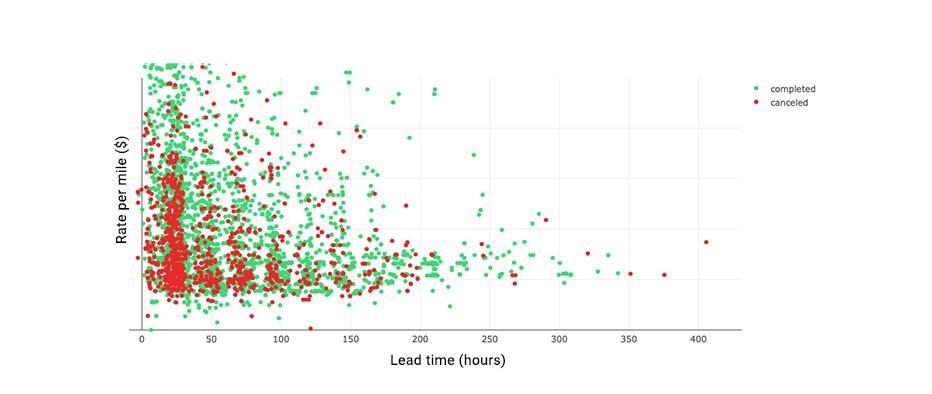Blog
Rate Volatility & Lead Time: Intermodal Freight Behavior in the Marketplace Model
The DrayNow platform provides many tools for users to understand current marketplace conditions which affect the competitiveness of their freight. This is great for getting feedback on each singular load, but what about the behavior of all freight on the platform? To answer that, we’re presenting a snapshot of how the marketplace functions, plotted out with anonymized data to represent the loads either taken by carriers or cancelled with no capacity.

The chart above shows the relationship between how many hours a load is posted on the DrayNow platform before its appointment (lead time), and the rate per mile in which that trip was priced at. The data was collected between August 1 – November 1 and reflects all pickup and delivery loads posted to the marketplace during that time.
As you can see, there’s a high concentration of expedited loads with shorter lead times across the board that end up cancelled, with the most being within 1-50 hours of the appointment. This is especially true for freight put up on the marketplace with prices that may have been competitive had they been posted earlier. For last minute coverage, it’s clear that carriers aren’t responding to that same price.
The data on this chart points to the notion that as rates rise, the incidence of loads not getting capacity decreases. For this rushed freight, there’s still a chance that the loads might not get taken mostly due to daily capacity availability, but it’s very apparent they aren’t being cancelled at the same rate as their lower priced counterparts.
This same logic can apply to loads that are posted well in advance (100+ hours). The data shows there are still instances of cancellations for that freight, but not quite as many. And when the rate per mile is priced higher, there’s an even greater chance of this freight getting capacity. This is because many carriers prefer to plan out their week rather than take a gamble and wait for something to show up a day or two before the appointment.
Getting capacity for such a last-minute trip is tough, but the data shows when the price is right, carriers are willing to fit it into their schedules. The next time you’re trying to decide on a trip’s rate, use this as a resource to guide your pricing decisions relative to the lead time for the load. The higher the rate per mile and the longer the lead time, the more likely the load will be taken by a carrier.
Sign Up
Shipping Freight? Get our new E-book.
Download our free e-book "Is there a future for Intermodal Marketing Companies?" and get DrayNow updates delivered straight to your inbox.
"*" indicates required fields